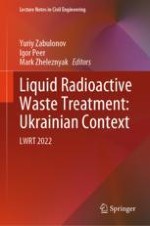2024 | OriginalPaper | Buchkapitel
Application of the Latest Design of Combined Adsorber-Settler Structure in the Purification (Deactivation) of Liquid Radioactive Wastes (LRW)
verfasst von : Sergiy Marisyk, Yevhen Matselyuk, Dmytro Charny, Yuriy Zabulonov, Tetiana Nosenko, Oleksandr Pugach, Mykhailo Rudoman
Erschienen in: Liquid Radioactive Waste Treatment: Ukrainian Context
Verlag: Springer Nature Switzerland
Aktivieren Sie unsere intelligente Suche, um passende Fachinhalte oder Patente zu finden.
Wählen Sie Textabschnitte aus um mit Künstlicher Intelligenz passenden Patente zu finden. powered by
Markieren Sie Textabschnitte, um KI-gestützt weitere passende Inhalte zu finden. powered by
